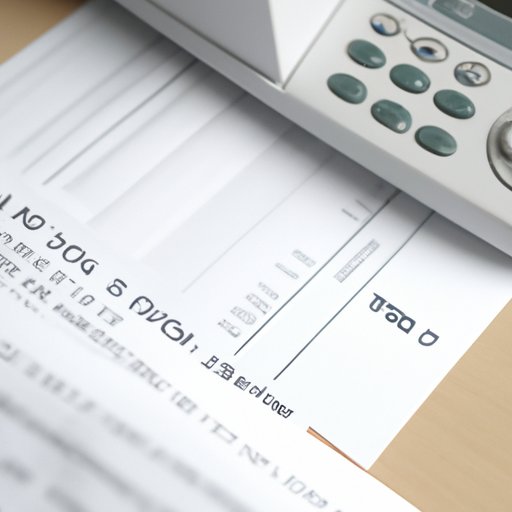
Introduction
One of the most important pieces of information you need for your bank account is your routing number. Without it, you can’t set up direct deposits, pay bills online, or even transfer funds between accounts. However, many people are unsure of how to find their routing number. In this article, we’ll provide a step-by-step guide and explore the different ways to find your routing number. By the end of this article, you’ll have all the information you need to locate it with ease.
Step-by-Step Guide to Finding Your Routing Number
There are two easy ways to find your routing number: through a physical check or through your online banking account. Here’s how to do it:
Find the Routing Number on a Check
Take a look at the bottom left-hand corner of a check. The routing number is the nine-digit code between the symbols that look like semicolons. That’s it! You can use this number to make electronic transactions or set up direct deposit.

Find the Routing Number Through Online Banking
If you prefer not to use physical checks, most banks will have routing numbers displayed somewhere on their online banking website. Simply log in to your account and look for the routing number under account information or account details. You could also check the FAQ section or use the search bar if you’re having trouble finding it.

Why Your Routing Number Matters and How to Find It
Your routing number is essential when it comes to financial transactions. For example, when you set up direct deposit with your employer, they’ll ask for your routing number so they can deposit your paycheck directly into your account. Similarly, when you make electronic transfers, the routing number is used to make sure the funds are credited or debited from the correct account. Here’s how to find your routing number:
Reach Out to Your Bank
If you prefer not to use physical checks or online banking, you can always reach out to your bank directly. Simply call customer service or visit a branch location and ask for your routing number. They’d be more than happy to help you out.
Check Your Account Statement
Your routing number will also be included on your account statements, whether they’re paper or electronic. Look for the nine-digit number towards the top of the statement.
The Top 3 Ways to Quickly Locate Your Routing Number
Use Your Bank’s Mobile App
Most banks will have a mobile banking app, and some of them even let you access your routing number through the app. Download your bank’s app from the App Store or Google Play and follow the steps to find your routing number.
Contact Customer Service
If you’re still not sure where to find your routing number, call your bank’s customer service line. They can look up your routing number and either tell it to you over the phone or send it to you via Email or text message.
Look Online
You can also try doing a quick search online, including your bank’s name and the phrase “routing number.” This should bring up several websites that list routing numbers for many different banks. However, be cautious of scams or fake websites when conducting your search.
A Beginner’s Guide to Understanding Routing Numbers
What Are Routing Numbers?
Routing numbersare sets of numbers that identify financial institutions and accounts in the United States. Every bank has one, and it’s typically nine digits long. The first four digits of a routing number identify which Federal Reserve Bank the financial institution is associated with, while the last five digits identify the specific bank or credit union.
Breaking Down Routing Numbers
If you look at a routing number, you’ll see that it consists of three groups of numbers separated by a dash. The first group of numbers is the Federal Reserve routing symbol, which denotes the Reserve Bank that your financial institution is associated with. Next, you’ll see the ABA institution identifier, which is a combination of the bank’s registration number and the check digit. Finally, the last number is the check digit.
The Do’s and Don’ts of Finding Your Routing Number
Do Double Check and Verify Your Routing Number
It’s always essential to double-check and verify that you’ve found the correct routing number, particularly when setting up direct deposit or making electronic payments. An incorrect routing number could cause delays in transactions or even result in the payment going to the wrong account.
Don’t Share Your Routing Number with Untrusted Parties
As with all financial information, it’s crucial to keep your routing number confidential and only share it with trusted parties. Be wary of any unsolicited email or phone calls that request your routing number, as these are often scams.
Conclusion
Knowing your routing number is essential when it comes to financial transactions. Thankfully, there are several ways to quickly locate your routing number, and now that you’ve read this article, you know them all! Remember to stay vigilant and always verify that you’ve found the correct number before making any transactions. By using the tips and tricks outlined in this article, you’ll never have to worry about not being able to locate your routing number again.




